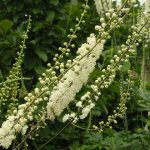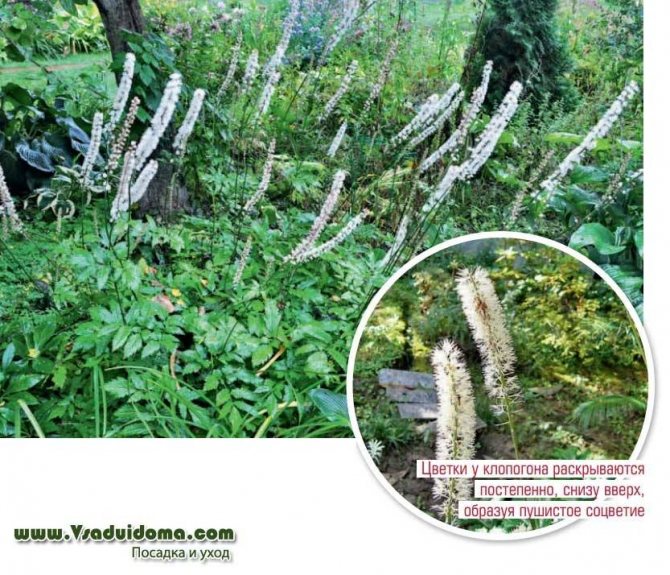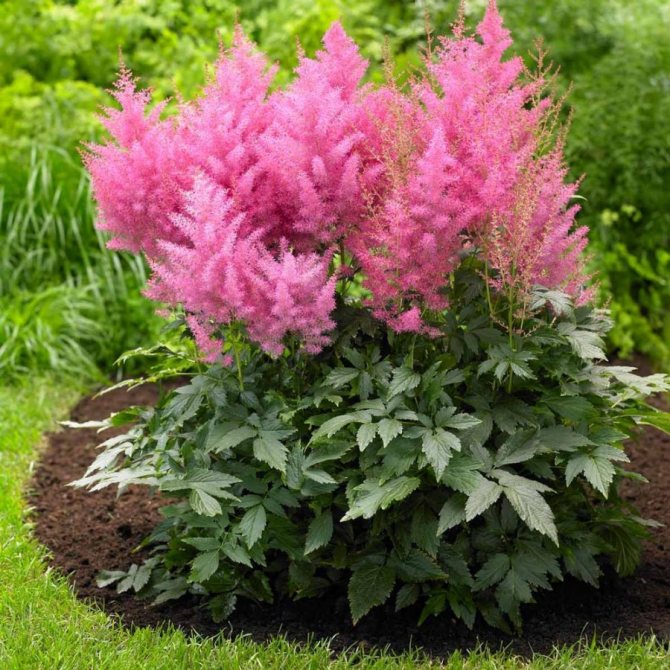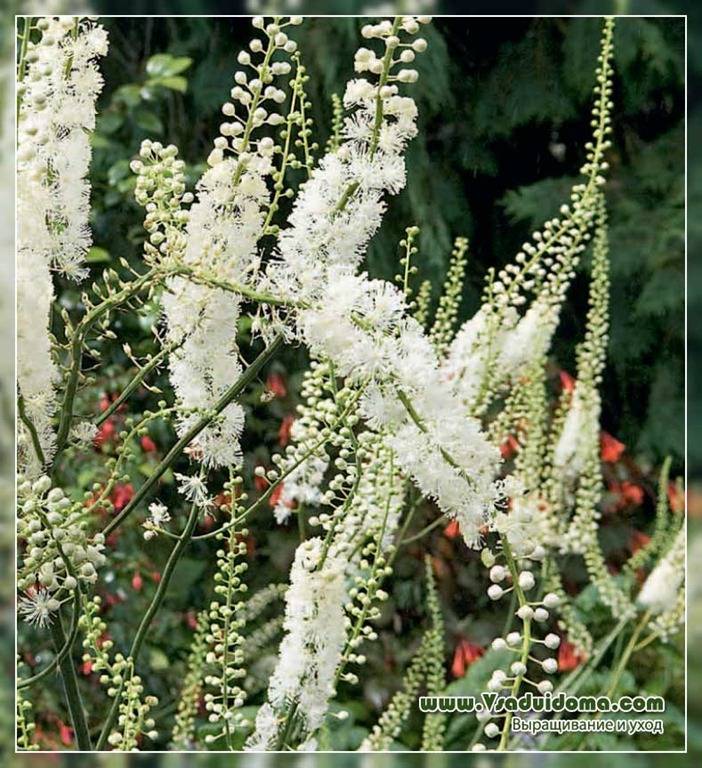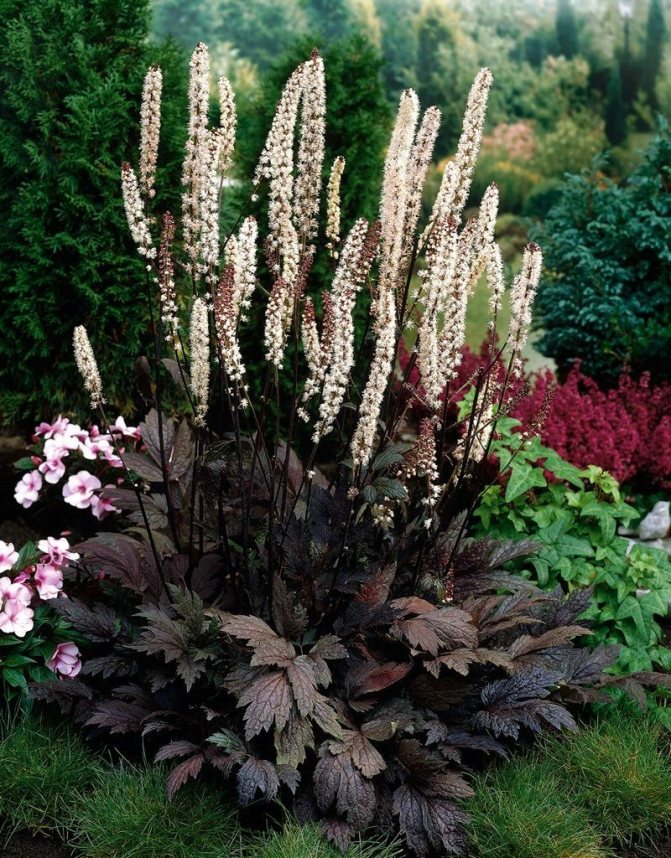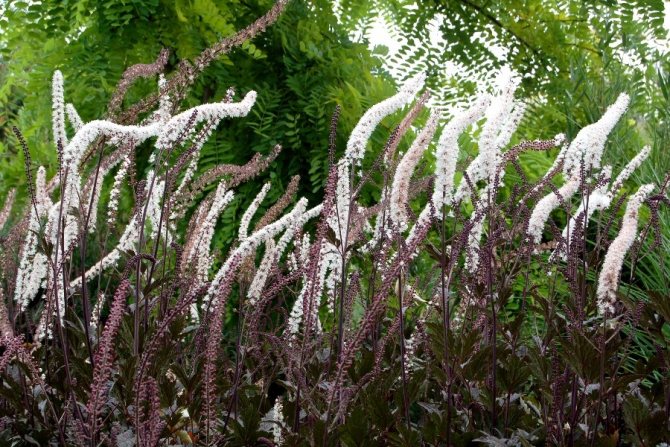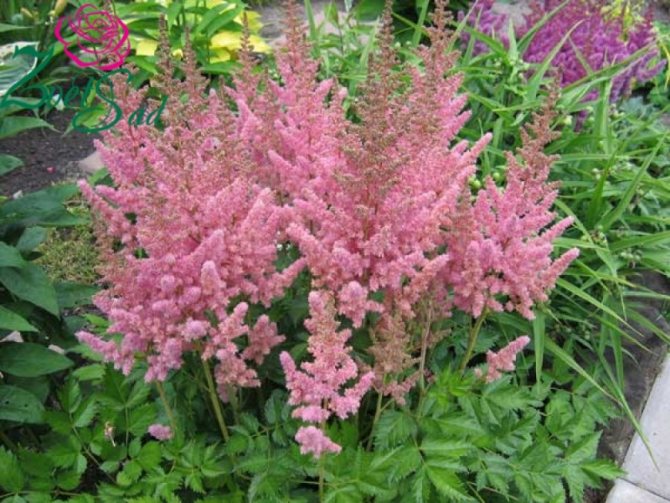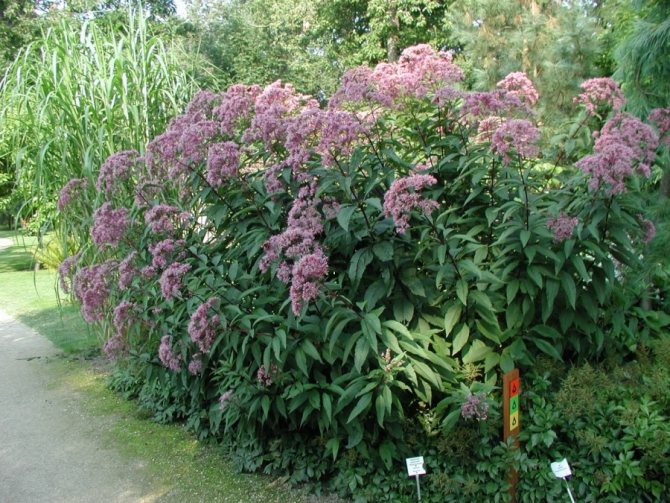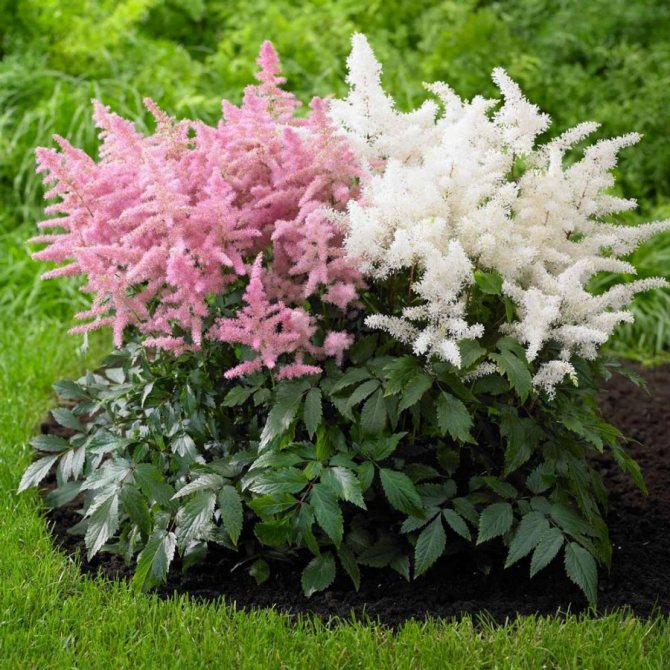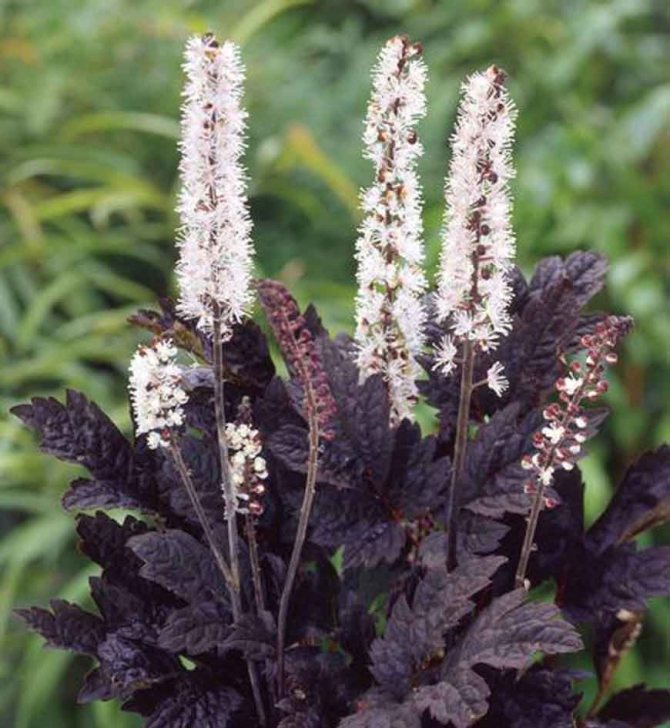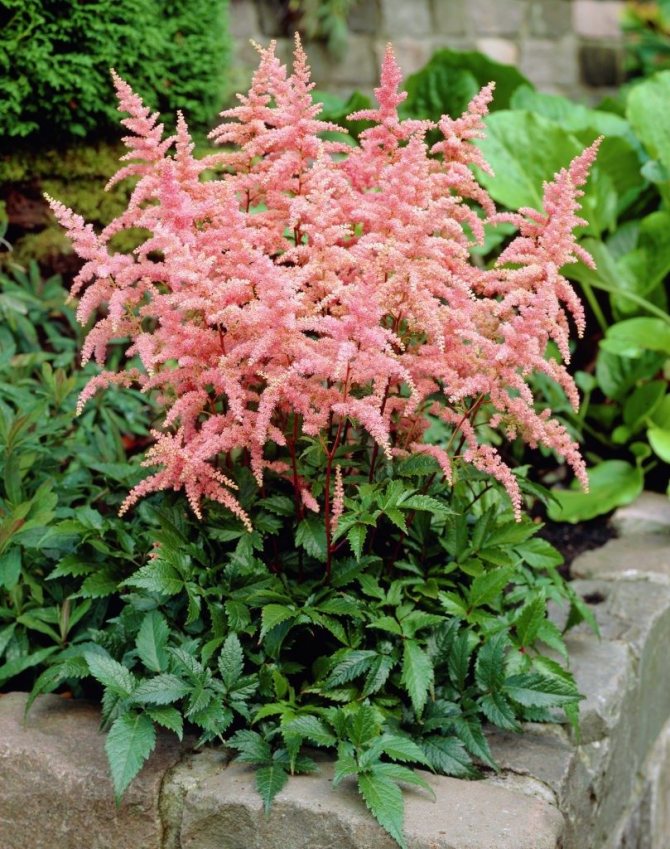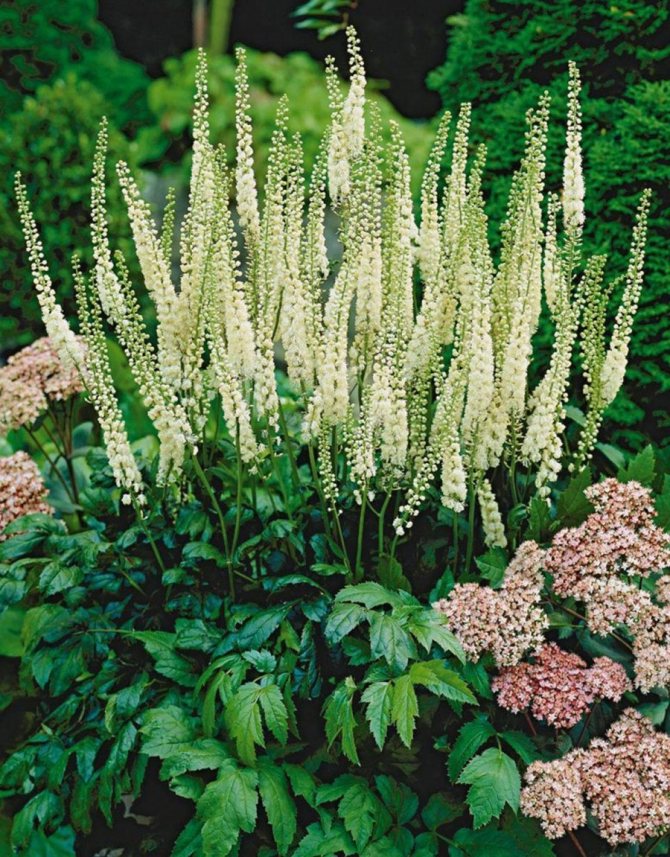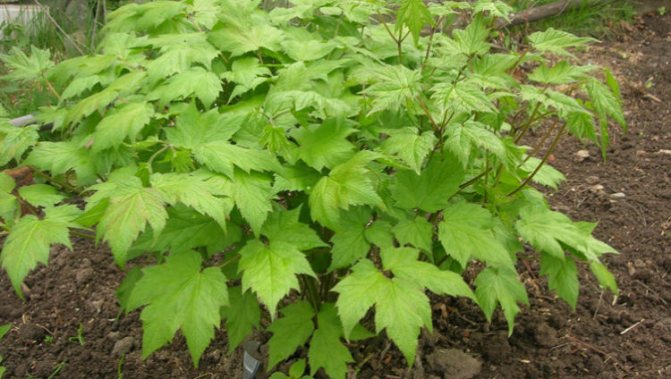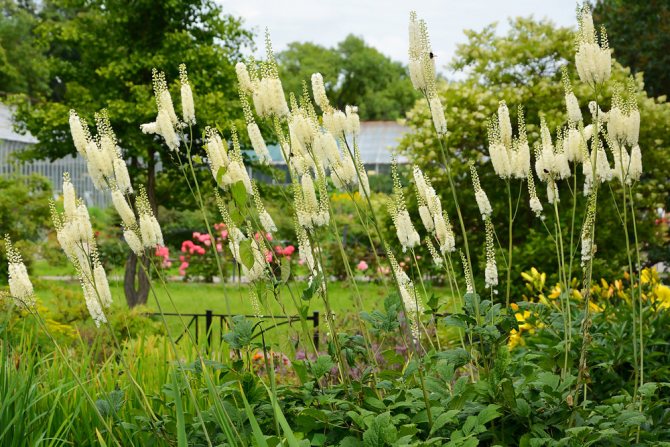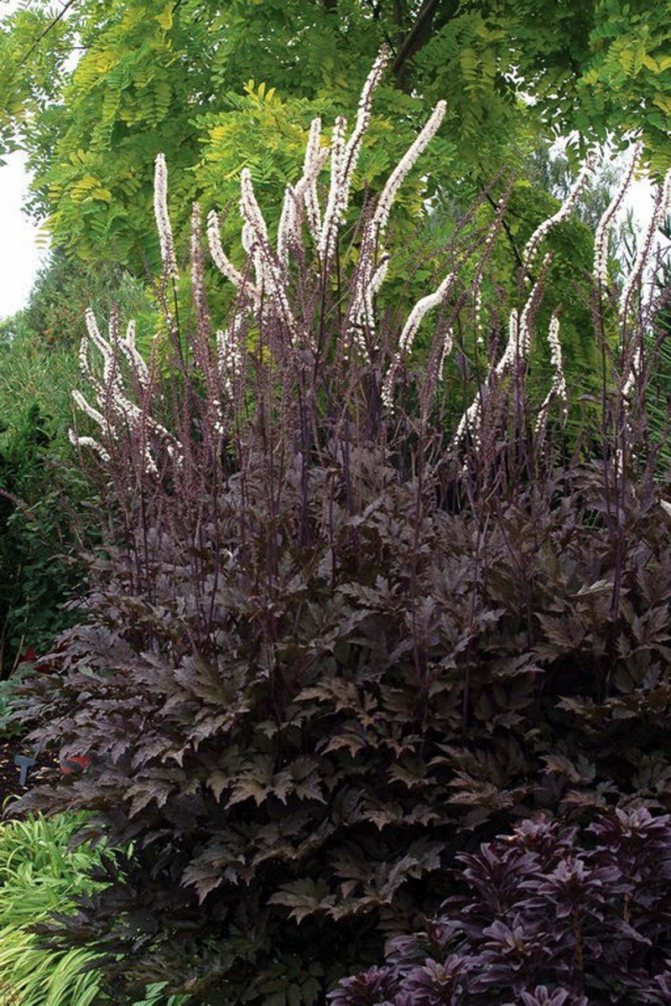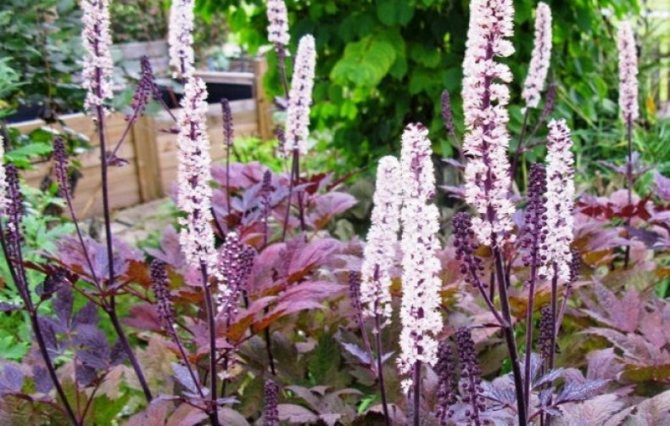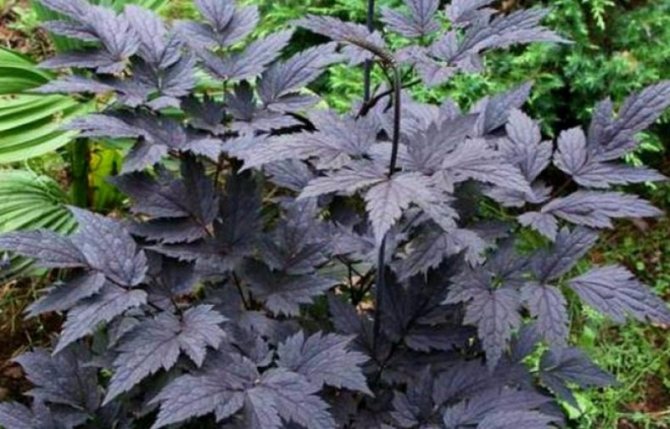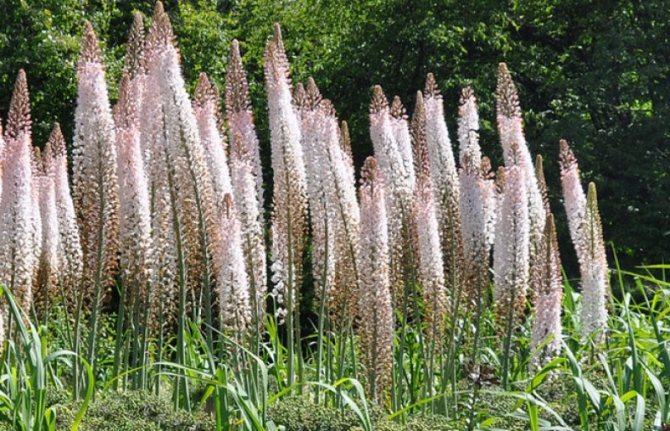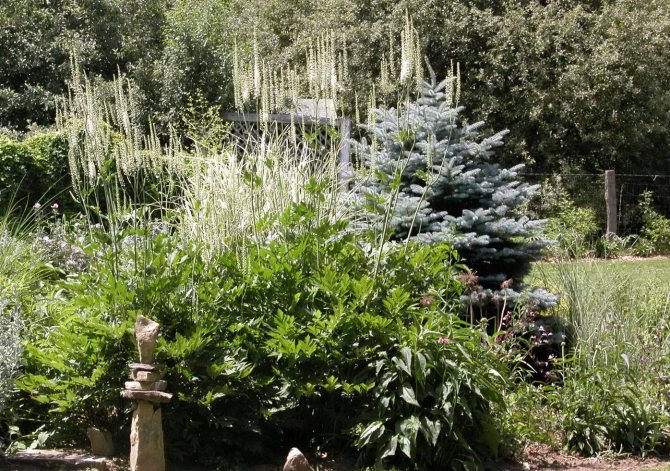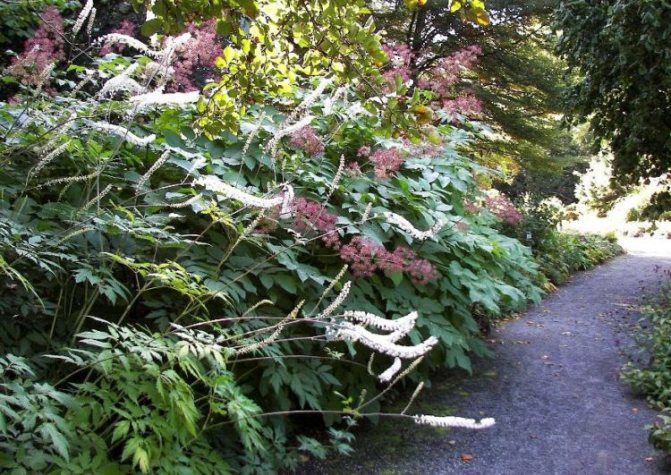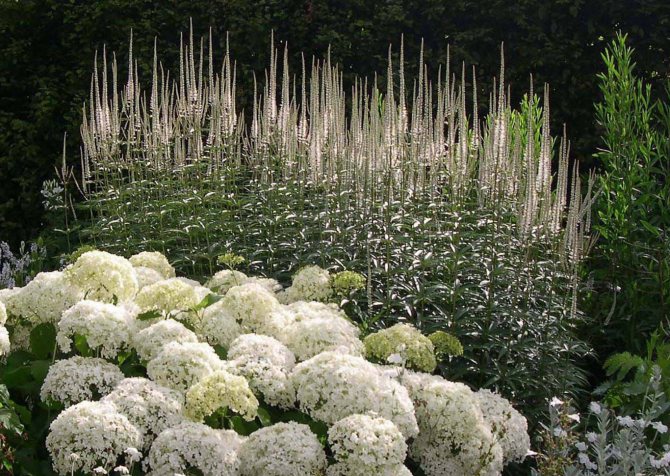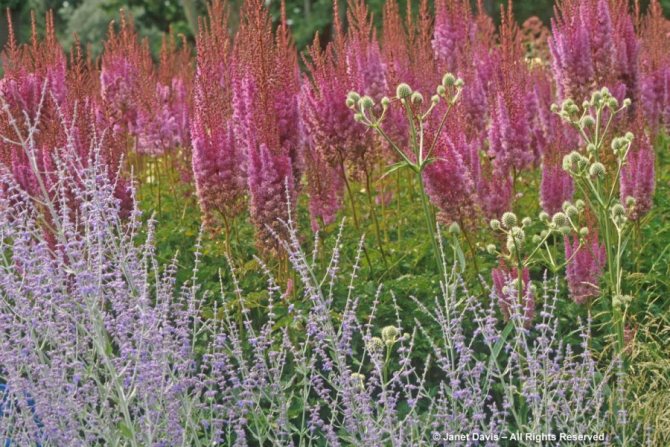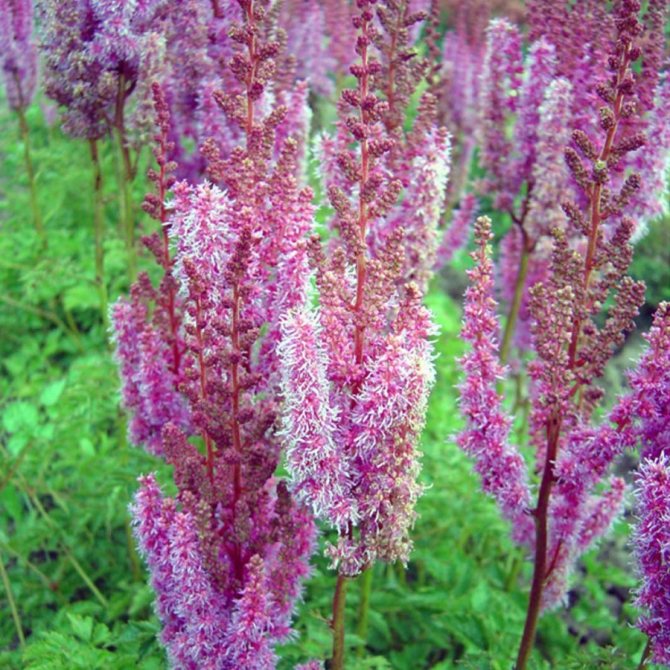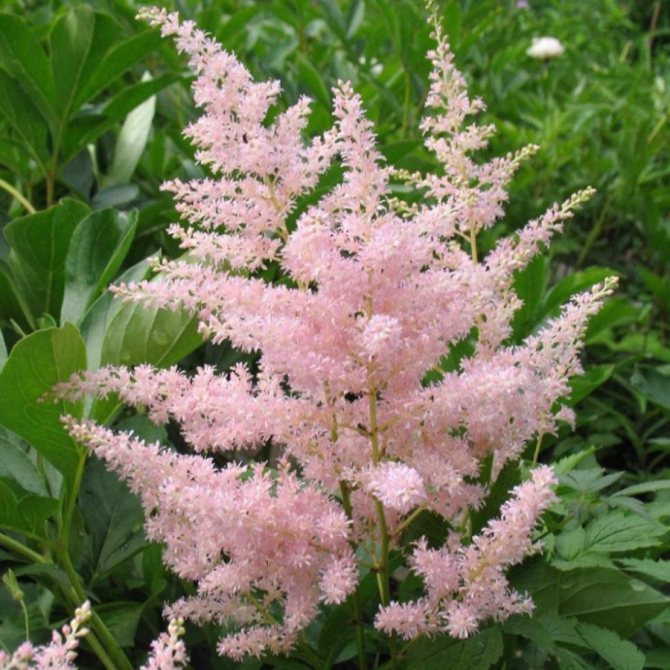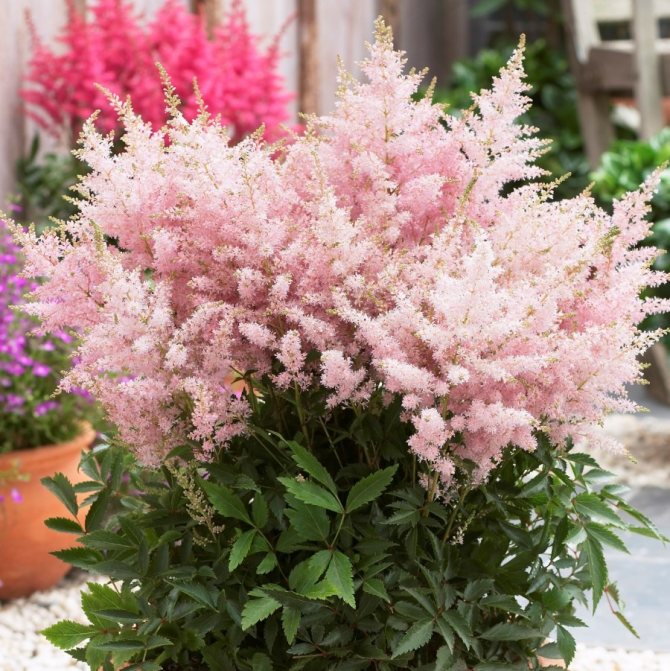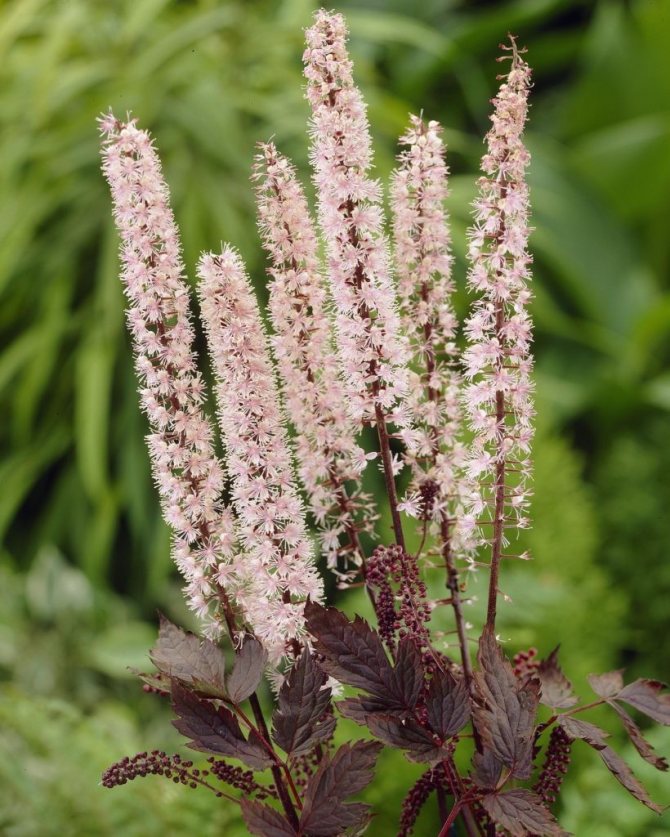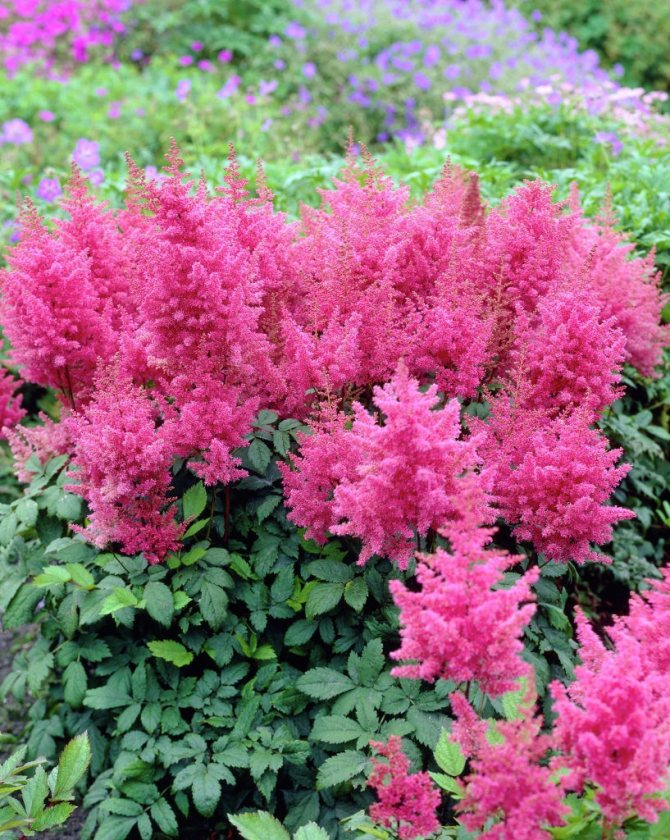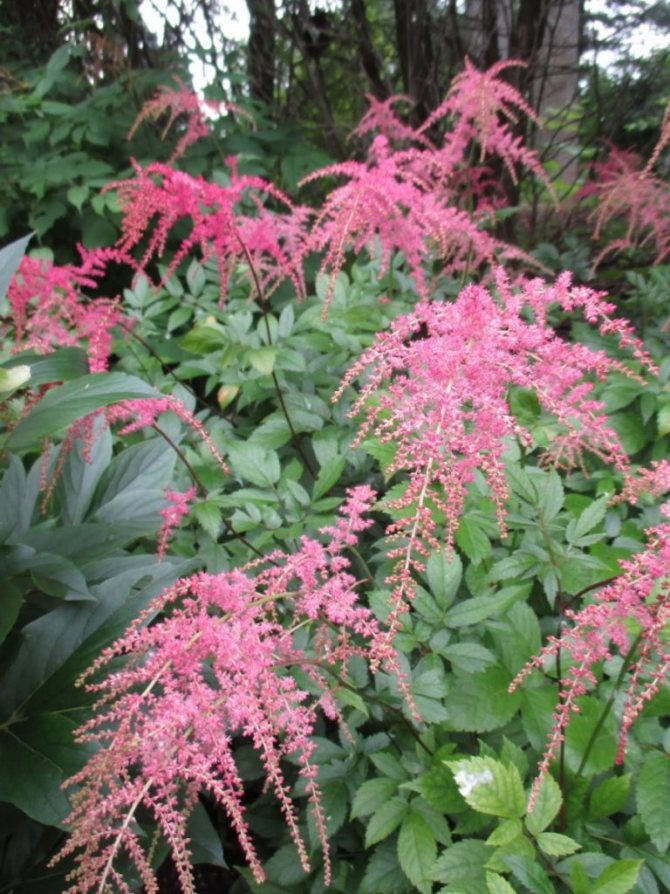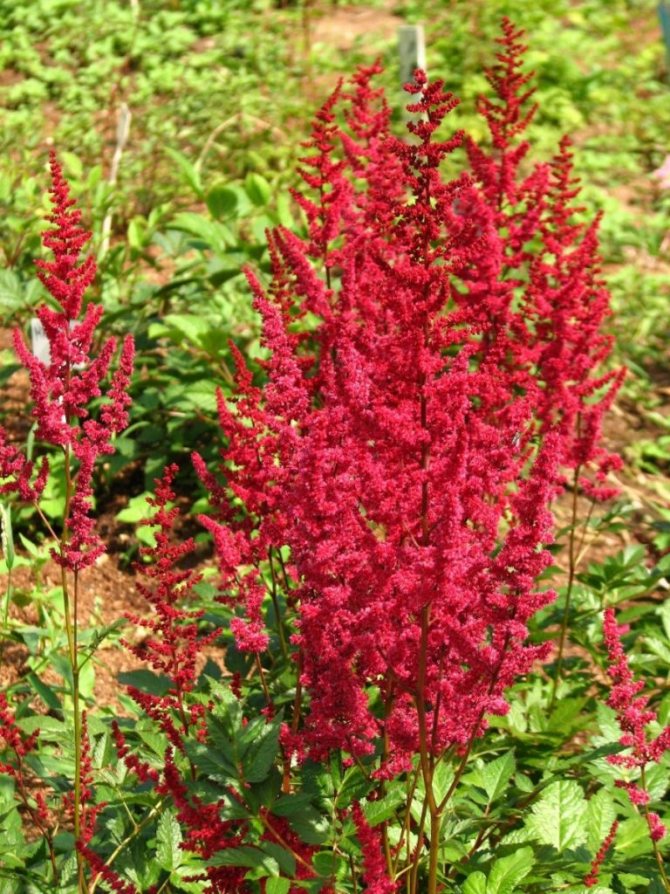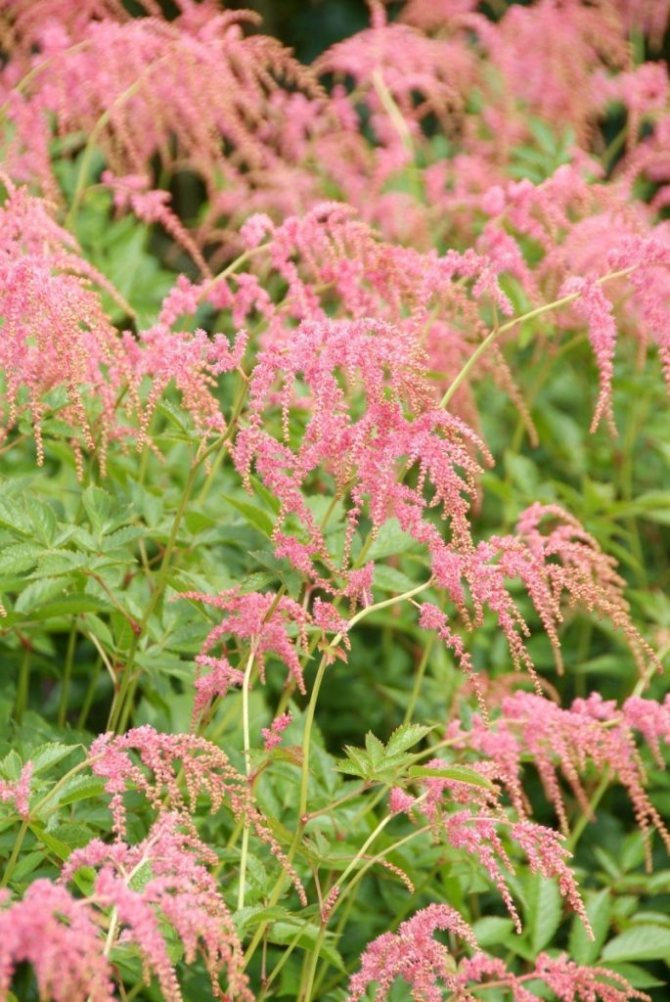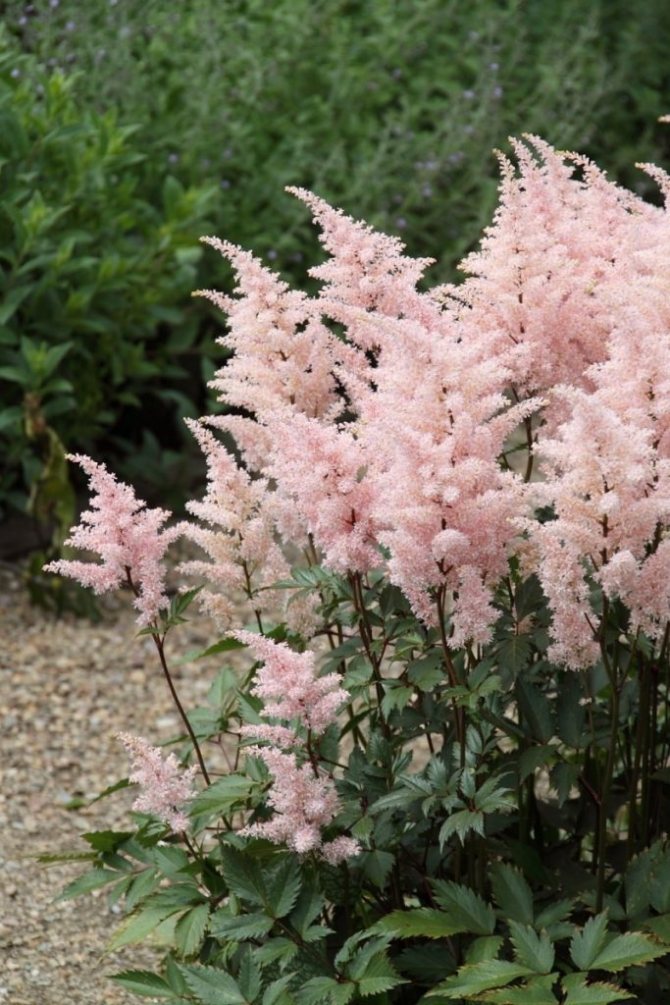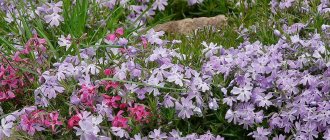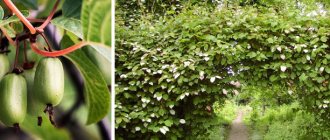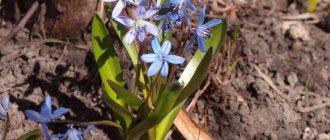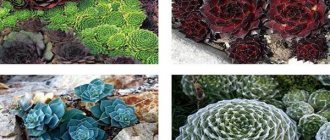Choosing ornamental plants for decorating a summer cottage, the gardener wants them to help achieve the most striking effect. Therefore, it is often possible to find a plant such as a cimicifuga in personal plots. It can be described as a spectacular and airy flower that can present even the most ordinary flower garden in a new light.
It looks no less attractive in those cases when grown singly... This plant can be considered a "muse" for the gardener, therefore, in recent years, it has been widely used in landscape design.
- 2 Popular varieties of black cohosh
- 3 Secrets of plant care
- 4 How to breed black cohosh?
4.1 Sowing seeds
- 4.2 Rhizome division
What is this plant "black cohosh"
Black cohosh or in Latin - "tsimitsifuga" in different cultures received different names. The green parts of the plant and the roots contain insecticidal substances that can repel insects, which is reflected in the Latin and Russian names of the culture. The most accurate description of the appearance and unusual beauty of flowers is their German name - "silver candles".
A large plant with tall, powerful peduncles can reach a height of 2 m.Depending on the variety and illumination, the average black cohosh grows from 40 to 100 cm.
With age, black cohosh develops a powerful root that goes deep into the soil. This provides a long-lived perennial with resistance to heat, frost, and drought.
Large, bright leaves rise from the ground, collected in a high growing rosette. Depending on the type, leaf plates can be colored in all shades of green, have a reddish, blue tint, or be completely chocolate-burgundy. The shape of the leaves is three times dissected, toothed, vaguely resembles a very large parsley.
One, rarely two strong shoots rises from the rosette of basal leaves. At the end, a large peduncle of a cylindrical or elongated-pointed shape is formed. Black cohosh inflorescence unites hundreds of small buds with small petals, but very long stamens, giving the flowers a fluffy appearance.
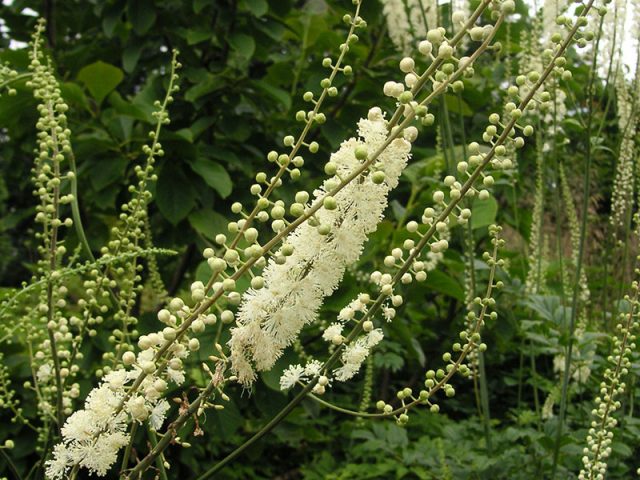
The color of black cohosh flowers depends on the variety and varies in a wide range from pale green to white and from bright pink to pale purple. The opening of the buds starts from the base of the "candle" and gradually rises to the tip. The flowering period can be extended up to 40 days, in early species it begins in July, in late ones - in September or October.
Popular varieties of black cohosh
Black cohosh genus includes many types, each of which has its own characteristics, therefore it is on them that you need to pay attention when choosing an option for creating flower arrangements.
- Black cohosh is branched. It is a tall plant that can reach a height of 2 meters. During the growing season, it forms small cream-colored flowers that form large, elongated inflorescences. The leaves of this type of black cohosh have a varied color, which can be red-chocolate, bronze or dark-cherry. Flowering occurs unusually late, unlike many plants - in September. However, if there is a lot of rainfall during the season, then the plant may not have enough time to form inflorescences.Therefore, it is undesirable to choose an area in the shade for planting.
- Black cohosh is simple. The characteristic features of this plant are small drooping inflorescences, which are formed by small flowers. This black cohosh variety has the worst case in cloudy summers, since in such conditions it is highly likely that it will not bloom. Within this group, it is worth highlighting the Brunet variety, which is in demand among many gardeners. It features a bronze-chocolate foliage that retains its rich hue throughout the season. Its white flowers, which turn purple at the moment of blooming, look no less attractive.
- Black cohosh racemose (cimicifuga racemosis). It is a tall perennial plant that usually grows up to 2 meters in height. It is decorated with fragrant inflorescences that have a candle-like shape, which open from bottom to top. Flowering begins in July and lasts until September. At this time of the year, the plant transforms as flowers that have a white or cream shade begin to bloom.
- Black cohosh is smelly. This species differs from other species by an unpleasant odor that comes from the aerial part of the rhizome. Many people know this variety under the name "Adam's rib", and he wears it for a reason, because its lower sheets strongly resemble ribs. The tallest are adult specimens, which can reach a height of 2 meters. Black cohosh leaves are large, feathery. Small flowers with a light green color are presented in the form of paniculate inflorescences.
- Black cohosh American. This plant stands out for its impressive size, as it can grow up to 90-150 cm. In the process of growth, forms dense bright green leaves. Flowering begins in July and lasts until the end of August: at this stage, it has cylindrical inflorescences-brushes, which form flowers of a gray-beige shade.
- Black cohosh daurian. Mature plants usually do not exceed 1 meter in height. Inflorescences have signs of pubescence, presented in the form of branched long candles. As a rule, they look a little drooping due to the small white flowers.
All varieties of black cohosh have their own characteristics, differing from each other in terms of flowering, size and shade of inflorescences.
The use of black cohosh in landscape design
The variety of species of cimicifuga in height, length of inflorescences, their color allows you to create many compositions on flower beds, alpine slides, borders. Black cohosh in garden design can both create a bright accent and become a backdrop for other plants.
For a single planting, you should choose high, bright varieties: European or Daurian cimicifuga, atropurpurea. The same species are often used to decorate the banks of reservoirs, grown along fences or walls. The medium-sized black cohosh looks good on prefabricated flower beds, and rock gardens, borders, flower beds are decorated with undersized cimifuga.
Black cohosh in landscape design, as seen in the photo, can be perfectly complemented by low-growing or cover crops. Hosta, maple leaves, anemone, perennial moss, and hoof not only decoratively frame the plantings of cimicifugi, but also serve as protection for the soil. Curly lungwort and brunera perform well the mulching function.
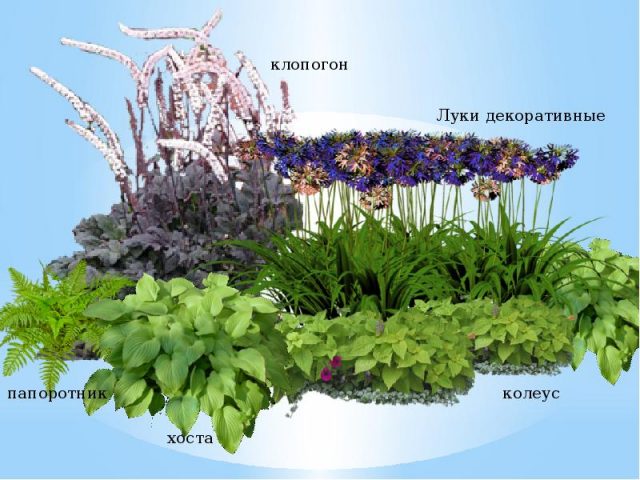

Attention! It is important to select plant species for the neighborhood with black cohosh that require similar growing conditions, feel good in humid, semi-shaded places.
Fern, aconite, sedge, buzulnik, astilbe grow well next to black cohosh. Conifers and incense serve as a noble background, highlighting the beauty of flowers and leaves.
In my garden
There are about 20 species of black cohosh. In our country, these plants are found in Eastern Siberia and the Far East. They also grow in Mongolia, Japan, China. They are common in the eastern United States, from Ontario to central Georgia; and from Missouri to Arkansas.
These are flowers of forest edges, wet meadows, bushes.
In black cohosh, the nascent inflorescences are very decorative; in the summer they decorate the plant with tiny buds in the form of beads.
A species grows in my garden black cohosh (Cimicifuga simplex)
... This species has pinnately complex long-petiolized green leaves 30–40 cm long, very decorating the garden. At the beginning of May, a curtain of basal leaves up to 40-50 cm high and shoots with several large leaves sitting alternately grow rapidly. And in early June, an inflorescence emerges from the shoot, which slowly grows all summer.
Black cohosh are one of the few flowers in which incipient inflorescences are very decorative; in summer they decorate the plant with tiny (up to 0.5 cm in diameter) stylish bead-shaped buds. In general, these are unhurried plants that do not tend to bloom quickly. But the wait for flowering is worth it. One fine autumn day, the balls burst, white stamens appear, located in a semicircle, and the inflorescence turns into a funny long brush.
Flocks of such tall brushes hover over the leaves, creating the verticality of the autumn garden. It is a pity that the aroma of this species is very weak, you can feel it only with your nose buried in the flowers. But it blooms for a long time, about a month. Black cohosh grows very well in my garden - I have to separate part of the curtain every year so that it does not interfere with neighboring plants.
How black cohosh reproduces
Having a perennial bush in the garden, it is easy to propagate black cohosh, getting several plants in the shortest possible time. To do this, you can use one of three methods: germination from seeds, cuttings, division of an adult bush.
Blooming, scented black cohosh from seeds is the most difficult to obtain. This will take about six months before germination and several more years of cultivation before the flowers appear. Vegetative methods are fast but unreliable. Black cohosh planting material often dies due to temperature extremes, bright sun or dry soil, waterlogged seeds are blown out.
Cuttings
The procedure for reproduction with parts of the stem works best in the spring. Black cohosh cuttings cut in the fall need to be rooted and reared before planting at home, which requires more attention. This method does not greatly disturb the mother bush, for reproduction it is enough to separate a leaf from it with a small fragment of the central stem (the so-called "heel").
From an adult cimicifuga bush, you can get several independent shoots that form every season around the main root. For guaranteed rooting, the cutting is placed with the heel in a growth stimulator for several days, and then planted in a loose, moist soil.
Comment! The advantage of this method of planting black cohosh is that flowers can appear on a seedling in the same season, and the mother bush suffers slightly from the procedure.
Dividing the bush
A healthy adult black cohosh bush grows in width every year and takes up more and more space in the flower bed. A 5-6 year old plant can already be propagated by dividing the bush into parts. The plant is preliminarily removed from the soil, digging deeply from all sides.
Divide the bush into several parts, depending on its age and size. Moreover, it is better not to damage the main rhizome, carefully cutting off only young shoots with shoots or living buds. Separated cimicifugi bushes are planted in other flower beds or grown in containers for better survival. The mother plant can be buried in the old place.
Growing black cohosh from seeds
Seed propagation is a more painstaking task, it is used only when necessary. The short shelf life and limited germination of the material complicate the task. Growing from seeds of a simple black cohosh has several features.
Step-by-step instructions and tips for seed reproduction of cimicifugi:
- The planting material collected in the fall loses its germination with each month of storage. Therefore, it is better to start planting immediately after flowering.
- Black cohosh is sown in containers with a loose substrate, and then left in a warm room (not lower than + 20 ° C) for 90 days. Planting is rarely watered, keeping the soil semi-dry.
- It is not recommended to cover containers with plastic for the "greenhouse" effect. Black cohosh seeds tend to decay under such conditions.
- For another 90 days, the containers will need to be kept at a temperature of about + 16 ° C, until shoots appear.
Sprouts are grown as normal seedlings. Planting plants in open ground is possible at any stage of development. It is important to monitor the air temperature in order to protect the seedlings from recurrent cold weather.
A young cimicifuga, when grown from seeds, will look like in the photo for several seasons. The bush develops and grows stronger, but flowers will appear on it only after 4-5 years.
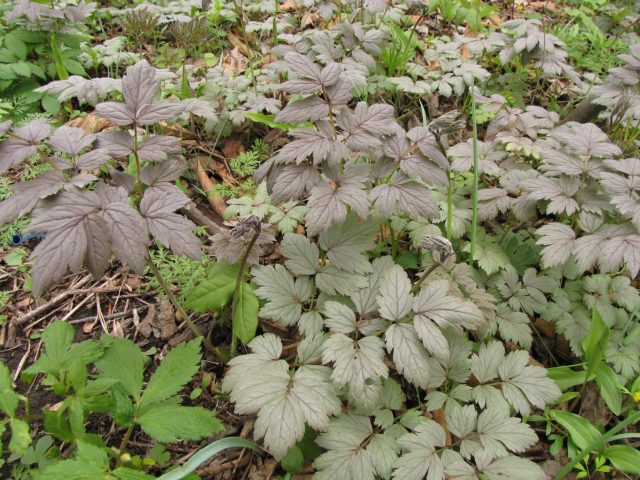

Important! A significant disadvantage of seed reproduction of black cohosh is the fact that seeds do not ripen in the middle zone. So in the Moscow region flowers often go under the snow, and in the cool season there may be no flowering.
How to choose the right variety
The selection of a variety begins with the determination of a suitable species. They take into account the characteristic features: frost resistance, soil quality, shade tolerance or love for an abundance of light, the size of the bush. If black cohosh is chosen for a single planting, preference is given to powerful bushes with a height of 1 to 2 m. Borders are decorated with low-growing plants with a height of 40 cm. If the variety easily tolerates moisture, the bushes can be planted near a reservoir in the yard.
Black cohosh planting is often combined with thuja. If the culture will grow with other ornamental plants, they must all be adapted to the same growing conditions.
More about black cohosh can be found in the video:
Planting and caring for black cohosh
Much of the success of a cimicifuga grows when it is planted. A perennial grows well up to 25 years old in a permanent place, while it is difficult for transplants. Therefore, the site should be evaluated very carefully. Correct planting and careful care of the Black Cohosh plant may not give results if the wrong place is chosen or the seedlings are inattentively selected.
When purchasing seedlings in a nursery or growing them yourself, you should carefully examine each sprout before planting in a flower bed. There should be no spots on the leaves, shoots, roots. When planting a black cohosh seedling, the buds should be alive or have already begun the growing season, and the shoots should not be lethargic.
Optimal planting time
Black cohosh can be planted in spring or autumn. Experienced gardeners recommend doing this after the end of cold weather and warming up the air to + 15 ° C. Planting in spring provides the black cohosh with an entire rooting season. Bushes leave matured before winter, so they are less prone to freezing or damping.
During the summer and autumn, the plant gains strength, adapts to the environment. By its state, the black cohosh bush manages to show whether the site for cultivation has been correctly selected.
Choosing the right place
The uniqueness of the cimicifuga is its ability to develop and bloom in partial shade. This property is highly valued by designers and hobby gardeners. Black cohosh makes it possible to decorate those places in the garden where other crops are reluctant to grow.
Advice! The best site for planting and growing black cohosh is considered to be partial shade or a place open to sunlight for only a few hours a day.
Soil preparation
Black cohosh, as a tall and abundantly flowering plant, needs enhanced nutrition. Prepare the soil for planting seedlings carefully:
- Dig up the selected area deeply, adding, if necessary, sand, peat, mineral dressing.There is no need to lime the soil - black cohosh loves acidic soils.
- Since the cimicifuga has been growing in one place for more than 20 years, planting pits are arranged no less than 50 * 50 cm with a distance of at least 0.6 m between the bushes.
- Drainage must be laid at the bottom of the pit: expanded clay, small stones, broken brick, gravel.
- About 1/3 of the hole is filled with organic fertilizers mixed with garden soil. Rotted manure, compost are used as a bookmark, ash or complex fertilizers are added. On heavy soils, sand is mixed.
With the correct filling of the planting pits, the black cohosh will develop well and will require additional feeding only after a few years of cultivation.
How to plant black cohosh
Plants are planted in the prepared holes when the average daily temperature exceeds + 15 ° C, and the threat of nighttime cold snaps passes. It is advisable to transfer plants along with a clod of earth. If the root system of the seedling is open, the roots in the hole should be straightened so that they are directed inward.
Do not compact the soil tightly when planting black cohosh. A planting hole filled to the top is spilled abundantly with water. After planting, it is useful to mulch the surface around the bushes with dry peat, grass or sawdust. This will conserve moisture and keep the soil loose.
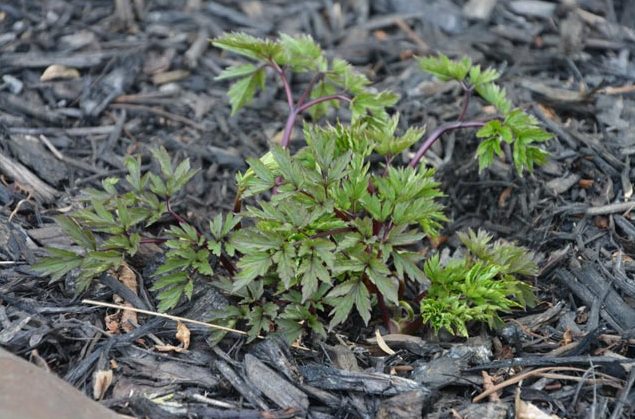

Attention! The mulch should not come close to the stems. About 5 cm of open ground is left around the black cohosh, otherwise the plant may vanish.
Planting a plant
Black cohosh feels better in shade or partial shade than in the sun. Contrary to popular belief, you shouldn't plant it under trees. Perennial prefers humus-rich soil. The place must be protected from strong winds.
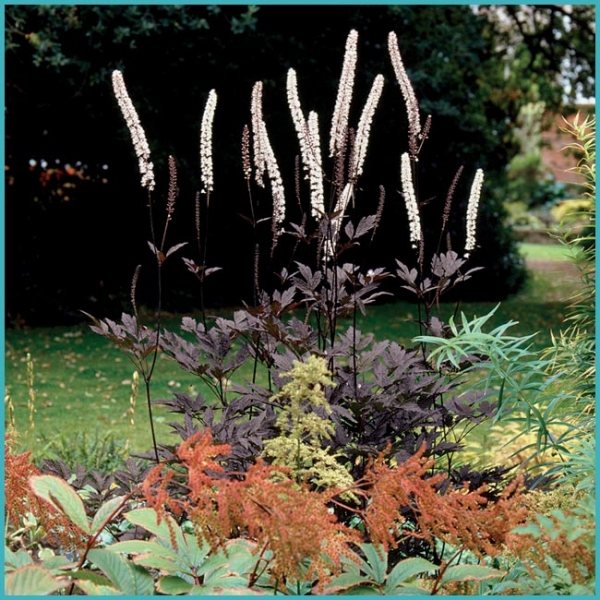

Black cohosh will decorate shady areas of your garden with its flowering
Choose fall or spring planting time. The depth of the hole is about 30 cm. Loosen the soil at its bottom and add organic matter there. Make the distance between plants at least 60 cm.
Advice. Tsimitsifuga does not really like transplanting and grows well in one place for 15-20 years.
Growing and caring for black cohosh
After planting, caring for the black cohosh flower consists in moderate watering, feeding, pruning. Preparation of the plant for winter is also an important point. You will not have to perform any more complex procedures when growing black cohosh.
Watering schedule
Black cohosh loves moisture and does not tolerate drying out of the soil, which is clearly signaled by wilting of leaves and peduncles. Overflowing flower beds can also cause bush disease. Growing in places with stagnant moisture leads to the death of plantings.
According to gardeners, it is better to water the plants rarely, but abundantly, giving nutrition to the deep-lying roots. In the heat, the bushes of cimicifugi, even in the shade, are watered every 3 days.
Does the plant need feeding
Black cohosh is sensitive to soil fertility, but the correct laying of planting holes completely provides the plant with nutrition for the next 3 years.
Since season 4, black cohosh is fed for lush flowering and decorative foliage. Nitrogen fertilizers are applied in early spring. When laying the buds, complex preparations for flowering crops or phosphorus-potassium mineral compositions are added to irrigation.
Advice! Black cohosh is responsive to organic feeding. Overripe manure or peat can be mulched over the bushes before the winter season.
Loosening and mulching
Weeds rarely annoy adult plants, because the black cohosh has a lush rosette of leaves, creating a thick shadow under the bush. Therefore, weeding beds with cimicifuga will rarely be required. It will simplify the care of ornamental bushes by mulching or growing short plants nearby in a flower bed.
A layer of organic bulk materials up to 5 cm will protect the flower bed from drying out, keep the soil loose for a long time. Sawdust, foliage, peat are used as mulch.
Preparing black cohosh for winter
An adult black cohosh tolerates the winters of central Russia well. Florists near Moscow claim that the cimicifuga winters well without any shelter. In areas with severe winters or lack of stable snow cover, plantings can be covered with a layer of leaves or spruce branches.
Important! For a good wintering of the roots, it is important not to feed the plant with nitrogen from the second half of summer. So the black cohosh root will have time to prepare for the dormant period by the fall, it will not deplete its strength by the excessive growth of foliage.
Do I need to cut black cohosh for the winter
Before the onset of cold weather, the stems and leaves of the plant are cut completely flush with the ground. This technique is usually sufficient to prepare the black cohosh for wintering. After pruning, young bushes can be mulched with a layer of up to 10 cm. This technique is especially relevant in areas with severe winters or frequent temperature changes.
Pruning black cohosh at other times consists in thinning the foliage, removing faded shoots and decorative shaping the bush. Such formation can be carried out at any time of the warm season.
Basic rules of care
Irrigation mode
In moderate weather, black cohosh can be watered once a week, but abundantly so that the earth is moistened to a greater depth. During the long absence of rain and high air temperatures, irrigation is carried out every 2-3 days.
Soil care
The soil periodically requires shallow loosening to ensure air permeability, and you will not have to deal with weeds. Weeds do not grow near the dense foliage at the base of the plant.
Top dressing
It is recommended to nourish the soil under flowering crops only 3-4 years after planting. Every spring, mineral or organic fertilizers are applied along with the irrigation water. This additional food will be sufficient for the entire season.
Pruning and garter
The garter is used to maintain the integrity of the flower stalks of tall varieties of flowering crops. The pruning procedure is carried out in the fall. During flowering, you need to pick off wilted flowers, and after flowering, all the stems are cut at the root.
Read also: What to do if indoor geranium does not bloom
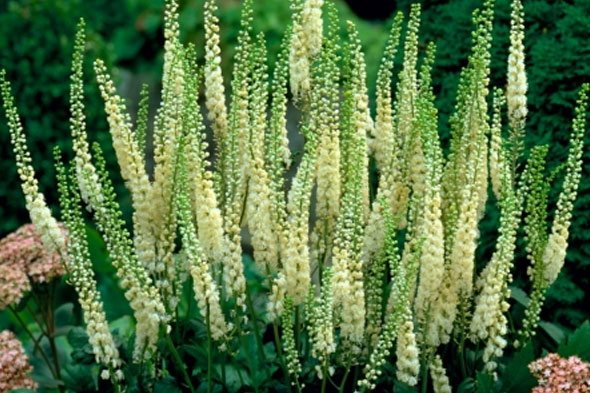

Preparation for wintering is necessary for decorative varieties of black cohosh. Their growing rhizome in late autumn can be covered with a layer of fallen leaves.
Black cohosh is not afraid of diseases and pests. In rare cases, due to significant violations of irrigation conditions and excess moisture in the soil, problems with its "health" may arise.
Diseases and pests
Correct planting and sufficient care of the black cohosh flower results in a healthy, strong shrub that is not prone to disease and is not damaged by pests. The culture has a high immunity to fungal infections, including scab.
The plant gets sick most often due to waterlogging of the soil. In combination with cold soil, this condition can provoke powdery mildew infection. Similar conditions develop in spring with unexpected nighttime cold snaps. For prevention, black cohosh leaves emerging from the ground are sprayed with Bordeaux mixture, Fundazol or Topaz.
Effects on the body during menopause
Tsimitsifuga contains phytoestrogen, which has a positive effect on the female reproductive system and hormonal levels in general at the time of menopause. Carpal black cohosh normalizes the work of DA and 5-HT hormones, acts on the ovaries, as a result of which the number of hot flashes is reduced.
The main plus in the use of drugs based on cimicifuga during this period is in the absence of a negative effect on the uterus and mammary glands, such drugs cannot provoke cancers.
In addition to positive interaction with hormonal levels during menopause, black cohosh improves the condition of the body's bone tissue. Organic compounds contained in the plant strengthen bones and prevent the formation of osteoporosis.
Tsimicifuga helps to lower blood pressure, normalizes the sleep and wakefulness cycle, improves mood, which is important during menopause.
Growing mistakes: why black cohosh does not bloom
Black cohosh foliage is bright, juicy, collected in luxurious bushes, decorative in itself. But, without waiting for flowering, novice growers are trying to find and eliminate the cause. Often the plant does not emit peduncles or the buds that appear do not open, regardless of the quality of care.
Possible natural reasons why black cohosh does not bloom:
- Lack of sunny days. Although the plant belongs to shade-loving, in a particularly cloudy summer, the flowers do not open, and the peduncles wither.
- Cold spring or sudden cold snap in summer. Black cohosh flowers cannot stand temperatures below + 15 ° C. Stems may not develop or buds may fall off.
- With prolonged drying out of the soil or the formation of a dense crust on the ground, the plant begins to save nutrients and the bloom of black cohosh may not occur.
- Growing in an area that is too sunny or completely shaded can produce beautiful foliage but leave the plant without peduncles.
Of mistakes in care, the main obstacle to the development of cimicifugi is excess moisture, which provokes root rot. The lack of trace elements is also detrimental to the condition of the bushes. The fact that it is time to feed the plant can be judged by the state of the leaves, which become pale, dry out or wither.
In many black cohosh inflorescences appear in the middle of summer, but the flowers do not open immediately. Late-flowering species may simply not have time to fully form in temperate climates. If the summer in the region is short, and it gets colder early in the fall, you should choose the earliest varieties of cimicifuga for growing.
Notes for gardeners about black cohosh
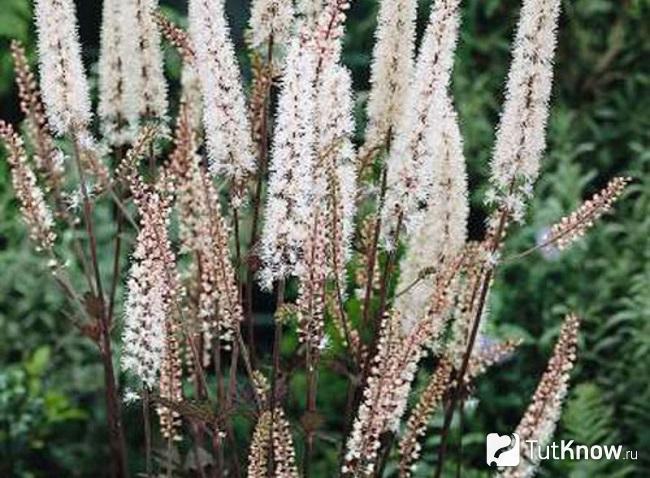

The stinking black cohosh (Cimicifuga foetida) has long been used by doctors in China and Japan as an antidote for snake bites, and also as a remedy for fever. The plant will help strengthen the body and strengthen generic activity. If a woman suffered from dysmenorrhea (painful menstruation) or the patient has bronchial asthma, snake root drugs were used. An aqueous tincture, powder or liquid extract from the rhizome of the plant was taken for headaches that were provoked by vasospasm. Such a remedy helped in diseases of the oral cavity, such as stomatitis, gingivitis or aphthae, now it is recommended for the treatment of periodontal disease.
Folk medicine men of Mongolia called the plant "Umkhi toad", since the term "battle" was translated as "castle in the air". Liquid and powder preparations based on it have been used as a pain reliever when joint pain occurs or to reduce fever. For diseases of the upper respiratory tract, preparations based on the leaves of black cohosh were used. They were also recommended if the patient suffered from anthrax, abscess and liver echinococcus. For diseases of the internal organs and spleen, an aqueous infusion of foliage was prescribed.
On the territory of Russia, this plant has long been considered a universal remedy for curing skin problems (urticaria, eczema, lichen, scabs provoked by fungi or scrofula).
There is a positive trend in the subsequent use of drugs based on black cohosh, in the treatment of diabetes and hypertension, bronchitis and malaria, they help to restore sleep and relieve swelling and swelling, it is used for cataracts and cardiovascular diseases.
Important!!!
It should be remembered that the black cohosh itself is poisonous, and if you use it thoughtlessly, it can lead to negative consequences. It is impossible to recommend such preparations based on a plant during pregnancy and lactation, thrombosis, stroke and allergy to the plant itself.Symptoms of poisoning are nausea and slow heartbeat, headache and sweating, constipation and osteoporosis, visual impairment and sweating.
Description of Black Cohosh
Black cohosh is a perennial plant with a permanent green color. It has wide, dissected leaves that are heart-shaped at the base, and white fragrant airy flowers, shaped like a brush, which gave him the familiar name to us - racemose. Black cohosh flowers exude a honey smell and, when blooming, unfold gradually from bottom to top.
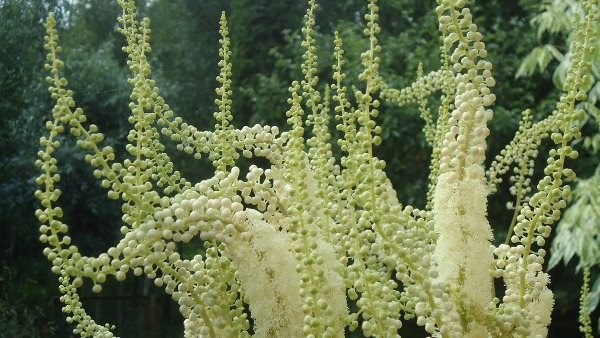

White buds on cimicifuga inflorescences
In addition to beautiful leaves and unusual flowers, he rich in a powerful dark brown root system, having dimensions up to 12 cm in length and up to 2.5 in width... Black cohosh reaches a height of up to 60 cm.
The marked sizes indicate how large this flower can be.
Cimicifuga grows in the forests of North America, since wet soils and darkened places prevail there, a favorite location for this is a representative of the flora.
Black cohosh blooms from mid to late summer, fruits appear in early autumn (September).
The plant's life span reaches 15 years.

